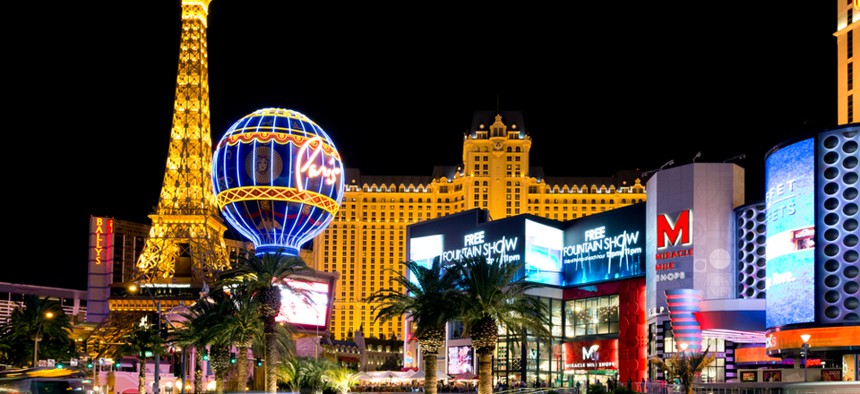Las Vegas Finally Antes Up for a Real Public Transit Network

topseller/Shutterstock.com
The city has commissioned a plan to expand mobility options on the Strip.
For all the showy excess of Las Vegas, the city's public transportation network is strikingly understated. That's especially true on that casino-laden part of Las Vegas Boulevard known as the Strip. Bits and pieces of transit do exist there—double-decker buses, a monorail connecting the SLS (formerly the Sahara) with the MGM via the convention center, a few tiny trams that link casino couplets—but they're no more related than roulette is to craps.
"There's no connectivity of one single system on the Strip," says Tom Skancke, head of the Las Vegas Global Economic Alliance and a board member for the Nevada Department of Transportation. For all the vehicle types on the boulevard, from taxis to limos to billboard trucks, the one thing missing is "a transit system that provides other modes for how people want to move," he says.
Well the city has finally anted up on a comprehensive transportation plan. The Regional Transportation Commission recently staked $2.7 million to engage the urban planning services of Michael Gallis, who will study the Vegas resort corridor and recommend how it can create (and pay for) a genuine cohesive mobility network. The plan is expected within the next year and a half.
The Strip is crammed with traffic on a daily basis. Between the visitors and the employees, the resort corridor hosts an estimated 155,000 people per square mile —a density that approaches that of Manhattan on a business day. Yet cars remain the overwhelming transport option for those near and far: Passenger rail doesn't serve the city, the monorail stops short of McCarran International Airport, light rail has never materialized.

Regional Transportation Commission of Southern Nevada
To Skancke—who calls himself a transit "convert"—providing more mobility options in Las Vegas is a matter of smart business as much as smart transport. Young professionals might prefer other major metros in the mountain and desert region that have reduced car dependence, such as Denver , Salt Lake City , and Phoenix . (To attract the same crowd, Zappos has planned a private ride-sharing network for its downtown Vegas headquarters.) Globally, other resort destinations have doubled down on rail access; Exhibit A, says Skancke, is the MRT subway station built right on the property of the Sands Marina Bay in Singapore.
"Las Vegas as a community is behind the rest of the world as it relates to global competitiveness and connectivity," he says. "We're the number one tourism destination in the world, but we don't provide the modes of transportation that will keep our community competitive going forward."
While it's far too early to tell what recommendations the new plan will make for Vegas mobility, Gallis is known for his work with Charlotte's emerging light rail system. And during an interview with the Las Vegas Sun in May, he suggested that a rail system will be strongly considered:
When we say mass transit, there are two forms: buses and fixed guideways, meaning rails. Bus ridership in Las Vegas is some of the highest in the United States. The road network has grown remarkably well and effectively. But it’s a new era. Looking at fixed guideway systems as yet another alternative is an extremely important step for us to take.
If rail does take center stage in the plan, it could face an uphill battle. Past attempts to bring light rail to the Strip have been greeted with skepticism and fought by road advocates until they failed . Meanwhile, plans have stalled for a high-speed rail line between Las Vegas and Los Angeles, as have plans to extend the monorail to the airport— despite recent increases in both ridership and farebox revenue.
On paper, at least, the Strip seems perfectly suited to a fixed transit system in an exclusive lane: it's a straight-shot through a high-density corridor loaded with attractions. If rail is a non-starter, the Strip might dedicate existing boulevard lanes to a bus rapid transit service. (May we suggest a free one paid for with on-board video slots?) And if any place can make a strong case for transit subsidies on the grounds of reducing drunk driving , it would have to be Vegas.
In practice, of course, there are financial reasons the Strip's transit network has come together so haphazardly. A mobility network that makes it easier for visitors to jump from casino to casino runs counter to the business strategy of keeping their wallets in one place. But Skancke believes the Strip might be more receptive this time around because resort ownership has been consolidated into fewer hands, and because the plan is being touted on its business merits.
"I've become an advocate for transit because one, it works; and two, it is a must be to competitive," he says.
(Top image via topseller / Shutterstock.com )





